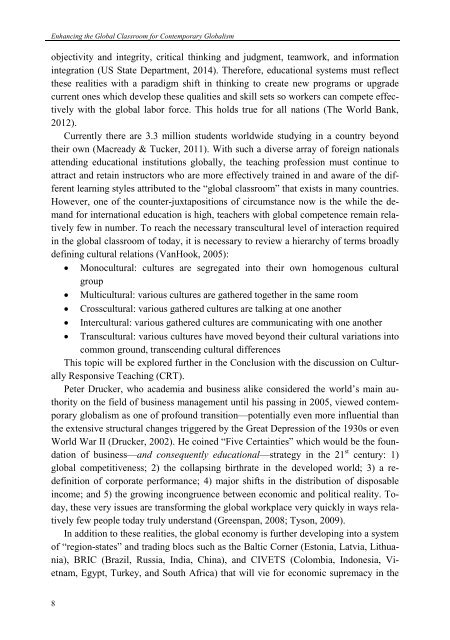Creating-entrepreneurial-mindset
Creating-entrepreneurial-mindset
Creating-entrepreneurial-mindset
- No tags were found...
You also want an ePaper? Increase the reach of your titles
YUMPU automatically turns print PDFs into web optimized ePapers that Google loves.
Enhancing the Global Classroom for Contemporary Globalismobjectivity and integrity, critical thinking and judgment, teamwork, and informationintegration (US State Department, 2014). Therefore, educational systems must reflectthese realities with a paradigm shift in thinking to create new programs or upgradecurrent ones which develop these qualities and skill sets so workers can compete effectivelywith the global labor force. This holds true for all nations (The World Bank,2012).Currently there are 3.3 million students worldwide studying in a country beyondtheir own (Macready & Tucker, 2011). With such a diverse array of foreign nationalsattending educational institutions globally, the teaching profession must continue toattract and retain instructors who are more effectively trained in and aware of the differentlearning styles attributed to the “global classroom” that exists in many countries.However, one of the counter-juxtapositions of circumstance now is the while the demandfor international education is high, teachers with global competence remain relativelyfew in number. To reach the necessary transcultural level of interaction requiredin the global classroom of today, it is necessary to review a hierarchy of terms broadlydefining cultural relations (VanHook, 2005):• Monocultural: cultures are segregated into their own homogenous culturalgroup• Multicultural: various cultures are gathered together in the same room• Crosscultural: various gathered cultures are talking at one another• Intercultural: various gathered cultures are communicating with one another• Transcultural: various cultures have moved beyond their cultural variations intocommon ground, transcending cultural differencesThis topic will be explored further in the Conclusion with the discussion on CulturallyResponsive Teaching (CRT).Peter Drucker, who academia and business alike considered the world’s main authorityon the field of business management until his passing in 2005, viewed contemporaryglobalism as one of profound transition—potentially even more influential thanthe extensive structural changes triggered by the Great Depression of the 1930s or evenWorld War II (Drucker, 2002). He coined “Five Certainties” which would be the foundationof business—and consequently educational—strategy in the 21 st century: 1)global competitiveness; 2) the collapsing birthrate in the developed world; 3) a redefinitionof corporate performance; 4) major shifts in the distribution of disposableincome; and 5) the growing incongruence between economic and political reality. Today,these very issues are transforming the global workplace very quickly in ways relativelyfew people today truly understand (Greenspan, 2008; Tyson, 2009).In addition to these realities, the global economy is further developing into a systemof “region-states” and trading blocs such as the Baltic Corner (Estonia, Latvia, Lithuania),BRIC (Brazil, Russia, India, China), and CIVETS (Colombia, Indonesia, Vietnam,Egypt, Turkey, and South Africa) that will vie for economic supremacy in the8





